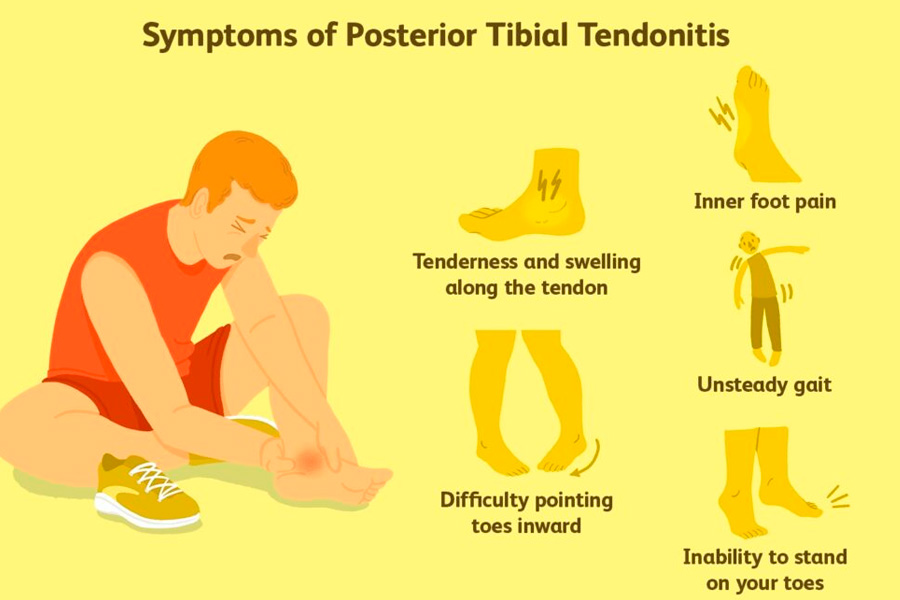The posterior tibial tendon is the main tendon responsible for supporting your foot’s arch and maintaining a stable foot position. When this tendon becomes inflamed, it can lead to a condition called posterior tibial tendonitis. The injury causes pain and swelling along the inside of the ankle and the base of the foot. If left untreated, posterior tibial tendonitis can lead to long-term damage and even require surgery.
You can manage this foot condition by doing the following:
1. Using the R.I.C.E. Method
The R.I.C.E. method stands for:
- Rest – Rest your affected foot and avoid activities that put a strain on the tendon
- Ice – Apply ice to the affected area for 15-20 minutes, several times each day
- Compression – Wrap the ankle and foot with an elastic bandage to help reduce swelling
- Elevation – Keep your affected foot elevated above your heart level to ease swelling
2. Taking Medication
Your doctor may prescribe medications to help reduce pain and inflammation. Over-the-counter pain relievers may be enough to manage symptoms. If the pain does not go away with rest and medications, contact your doctor. Only take your pain relievers as prescribed. Do not take more than what is recommended by your doctor.
3. Doing Stretching and Strengthening Exercises
Stretching, range of motion exercises, and strengthening exercises can help reduce pain and improve flexibility. Your doctor or physical therapist can recommend specific exercises to help strengthen the tendon and reduce inflammation.
These include:
- Calf stretches – stand facing a wall with your hands against the wall. Step forward with one leg and keep your back leg straight while bending your front knee.
- Ankle circles – loop your ankle and move it in a circular motion.
- Heel-raises – Stand on the edge of a step or platform and raise your heels up, then lower them back down.
4. Wearing Properly Fitted Shoes
Wearing shoes that fit properly and provide good arch support can help reduce the symptoms of posterior tibial tendonitis. Choose shoes that are flexible, lightweight, and have a wide toe box. Avoid wearing high heels or shoes with a narrow-toe box.
5. Visiting a Foot Doctor
If the pain does not go away with self-care measures, visit a foot doctor. They can diagnose the condition and recommend treatments to reduce pain and inflammation.
Options include:
- Corticosteroid injections – may be used to reduce inflammation around the tendon
- Custom orthotics – arch supports that help reduce strain on the tendon
- Surgery – If all other treatments fail, surgery may be needed to repair the damaged tendon
Surgery is often reserved for severe cases that do not respond to other treatments. Should you need it, the operation may include:
- Removing scar tissue from around the tendon
- Repairing tears or ruptures in the tendon
- Relieving pressure on the tendon by cutting the heel bone or transferring another tendon
When to Visit a Foot Doctor
Contact a podiatrist right away if you experience:
- Severe pain or swelling in your ankle
- Loss of flexibility in your ankle
- Intense throbbing in your foot
- Difficulty walking or bearing weight on your foot
Along with treatment, the doctor can recommend techniques to prevent future injury and help you get back to an active lifestyle. These include:
- Stretching and strengthening exercises
- Wearing shoes with good arch support
- Avoiding activities that put too much strain on the posterior tibial tendon
- Modifying activities to reduce the amount of strain on your feet
Posterior Tibial Tendonitis Treatment Near You in Cincinnati, OH
Posterior tibial tendonitis can be painful and debilitating, but there are ways to manage the symptoms. Use the R.I.C.E method for pain relief, take medication as prescribed, do stretching and strengthening exercises, and wear properly fitted shoes. You should also visit your foot doctor if the pain does not go away with self-care measures. They can diagnose the condition and recommend specific treatments to reduce pain and inflammation.
Need effective posterior tibial tendonitis treatment near you in Ohio? Cincinnati Foot & Ankle Care (CFAC) can provide the comprehensive care you deserve. Call one of our 17 locations across southwest Ohio today, so we can assist you. You can also submit an online appointment request form to book a visit with the best foot surgeons near you.
We look forward to helping you manage your posterior tibial tendonitis!


